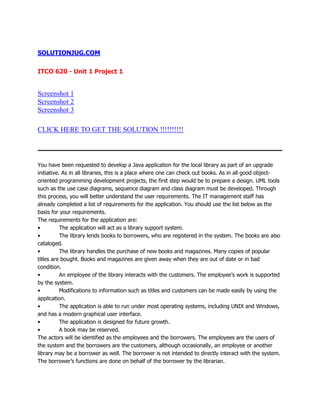
Library Management System UML Diagrams
- 1. SOLUTIONJUG.COM ITCO 620 - Unit 1 Project 1 Screenshot 1 Screenshot 2 Screenshot 3 CLICK HERE TO GET THE SOLUTION !!!!!!!!!! You have been requested to develop a Java application for the local library as part of an upgrade initiative. As in all libraries, this is a place where one can check out books. As in all good object- oriented programming development projects, the first step would be to prepare a design. UML tools such as the use case diagrams, sequence diagram and class diagram must be developed. Through this process, you will better understand the user requirements. The IT management staff has already completed a list of requirements for the application. You should use the list below as the basis for your requirements. The requirements for the application are: • The application will act as a library support system. • The library lends books to borrowers, who are registered in the system. The books are also cataloged. • The library handles the purchase of new books and magazines. Many copies of popular titles are bought. Books and magazines are given away when they are out of date or in bad condition. • An employee of the library interacts with the customers. The employee’s work is supported by the system. • Modifications to information such as titles and customers can be made easily by using the application. • The application is able to run under most operating systems, including UNIX and Windows, and has a modern graphical user interface. • The application is designed for future growth. • A book may be reserved. The actors will be identified as the employees and the borrowers. The employees are the users of the system and the borrowers are the customers, although occasionally, an employee or another library may be a borrower as well. The borrower is not intended to directly interact with the system. The borrower’s functions are done on behalf of the borrower by the librarian.
- 2. First, create a class diagram of the library application from these requirements. Your classes will correspond to Borrower, Item, etc. Each will be a class. You can use any UML tool you have access to or you may use Word to create the diagram – just make sure it is legible. Be sure to explain your class diagram in some detail. Second, identify what the library system will be used for and who will be using it. These are the use cases and actors, respectively. All use cases must begin with an actor, and some will end with an actor as well. Actors are people or other systems that are outside of the system you are working on. Prepare five use case diagrams. There should be one diagram for each of the following: lending a book, returning a book, removing a book, adding a customer and updating/removing a customer. You may think of others but you must develop one use case diagram for at least these five. Each use case should be documented. Include the use case name, actors and description. Next prepare the sequence diagram that illustrates the library system as a whole. Your UML diagrams must be included in a Word document. The document must be APA style. Screenshot 1 Screenshot 2 Screenshot 3 CLICK HERE TO GET THE SOLUTION !!!!!!!!!!